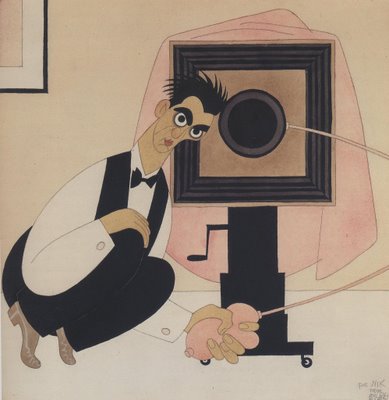
Before Hollywood began making pictures that moved and talked, illustrators who created the still pictures for popular magazines were national celebrities. Successful illustrators were paid huge sums, received hundreds of fan letters and hung out with the "beautiful people" of their day.

No illustrator was more of a celebrity in the 1920s than the now forgotten Ralph Barton, whose work appeared in the New Yorker, Vanity Fair, and in books such as Gentlemen Prefer Blondes. A notorious womanizer, Barton lived a fast life and went to glittering parties in Paris, London and New York with friends such as Charlie Chaplin, George Gershwin, H.G. Wells, Clarence Darrow, H.L. Mencken and the Barrymores. He was reputed to be the highest paid artist in New York City.
At the peak of his fame, Barton fell in love with a sultry young Broadway starlet with the exotic name of Carlotta Monterey. She was allegedly the daughter of Danish aristocracy.

It turned out that Carlotta's real name was Hazel Taasinge. She was the unwanted daughter of a poor fruit farmer from a small town in California. Abandoned at age four, she worked as a housekeeper but was crowned Miss California in 1907. After that, she used her looks to secure a bit part on Broadway where she was "appallingly bad."


Carlotta's Broadway career flopped, but she moved in with Barton who soon divorced his second wife in order to marry Carlotta.

Despite his love for Carlotta, Barton could not quite let go of his philandering ways. Carlotta walked in on Barton in bed with some "country club type" so she divorced him. She didn't ask for alimony, just "my Krazy Kat clippings in a Chinese lacquer box." (Clearly Carlotta had the right priorities). Soon she set up housekeeping with the great playwright, Eugene O'Neil.

Too late, Barton realized that Carlotta had been "the one." He became fixated on getting her back. His career went into a precipitous decline. He could not work without his muse. His health suffered, and he lost much of his fortune. But Carlotta never returned. He wrote one last impassioned plea to "my dear lost angel" but the note arrived in Paris the day after Carlotta and Eugene O'Neil sailed for New York. Despondent, Barton dressed himself in his silk pyjamas, wrote a suicide note, lay down on his bed with Gray's Anatomy opened to a picture of the human heart, and killed himself. He was 40 years old.
I find it fascinating that an artist who was so jaded-- a smug, sophisticated veteran of countless affairs on several continents-- could no longer work-- or even go on living-- without Carlotta, the small town girl with the made up past.